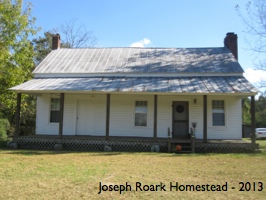


A Tribute to Marleita Roark Carmichael
by Johanna Eggers Roark
(From January 2020 Newsletter)
It was October 2012, and my husband Terry L. Roark, (Past President 1986, 2019-2020) and I packed up the car and headed to Cleveland, Tennessee for the 54th Roark-Conner Association (R-CA) Reunion. It was my very first time attending a Roark-Conner Reunion. I remember meeting many cousins, eating delicious food, having lots of fun, and visiting family historic sites.
Gene Johnson (1942-2020) was the President, and all of my “new cousins” greeted me very warmly. Saturday morning started with a well-organized business meeting and a touching Memorial Service to remember family members who had passed, followed by an interesting presentation on Doc Lewis Conner. The first day ended with a large evening banquet featuring live music, an auction, and lots of fun door prizes.
On Sunday morning, we gathered at the Salem Baptist Church site for a worship service to honor the ancestors, and then the cousins drove to the historic Cherokee Removal Site for a wonderful catered lunch. That afternoon was free for touring, so Terry and I decided to visit the Joseph Roark homestead. It is located on a bluff just south of Grasshopper Creek on Birchwood Pike. That year Marleita Roark Carmichael, the owner, had invited everyone to visit the homestead, just as she had been doing since the mid 1990’s.
Marleita talked with great pride about all the families that had lived in the homestead. It was built by Joseph Roark (1813-1876) about 1833. Joseph and his wife Juda Carr Roark (1813-1883) raised their children and lived the remainder of their lives in the homestead.
After Joseph passed away in 1876, his youngest son, William Marion (1843-1923), inherited the property. William and Virginia Ann Conner (1852-1934) married in 1878, shortly after the end of the War Between the States, and they raised their children there.
In 1914, William Marion and Virginia had given portions of their property along the Tennessee river to five of their children. They had also given equal and undivided interest in the remaining 308 acres, including the homestead, to Joe and William Grover, the eldest and youngest sons.
William Marion lived at the homestead until his death in 1923. In 1932, William Grover (1892-1972) and his wife Willie Myrtle (1895-1980) moved in with their family, and helped support his mother, Virginia. She lived there until her passing in 1935.
In 1939, Joe and his brother William Grover divided their interest in the 308 acre homestead tract, and Joe surrendered title to William Grover of 154 acres including the homestead. William Grover then sold the 154 acres to Margaret Adlaid McCallie and Sarah Jane McCallie, second cousins to William Grover. The unmarried sisters lived there until 1953, when they sold the property to Thomas J. Johnson and Mary McCallie Johnson, who then sold it to Lucille Boyd in 1975, but the Johnsons retained a life estate for themselves.
Following the death of the Johnsons, the homestead was unoccupied for seventeen years and fell into disrepair. Title to the property remained outside the immediate descendants of Joseph Roark until Margene Roark Higham, daughter of Franklin Asberry Roark and great-granddaughter of Joseph, purchased it. In 1992, Marleita, a daughter of William Grover Roark, and also a great-granddaughter of Joseph, purchased the homestead from Margene and began restoring it.
During our visit, Marleita was a perfect tour guide as she talked lovingly about the Roark homestead. I walked around with her admiring the beautiful log construction. The original building was 20 feet by 20 feet, built with split walnut logs held together by wooden pegs, chimneys of hand fired brick, and an east wing for the kitchen and dining room. Joseph and Juda moved into the home with three small daughters and added to the cabin as the family grew.
Sometime about 1843, Joseph enlarged the homestead, adding a twenty foot by twenty-foot room off of the main room with the large fireplace. The addition was of the same construction as the main room — planed logs with weatherproofed caulking and a roof of homemade shaved shingles. A loft was added to provide additional sleeping space, particularly for the boys as they grew older. The “east wing” was not added until even later. Joseph and Juda had 14 children, and for four generations, the homestead served as the principal dwelling of the Roark family.
Since taking ownership of the homestead in 1992, Marleita had made significant improvements, and her family was always there to help. Some of the improvements included:
– In 1994, they replaced the chimney, saving the bricks so that relatives could have one.
– In 1996, Marleita, Ruth Henry, Ola Mae Neal, Cooter and Pete Folkner, and Addie and Wenton Gross replaced the porch and supports under the back of the house, and they cleared the underbrush.
– In 1998, they completed fencing the property.
– In 2004, they put all new windows in the homestead and had the tin roof painted.
– Marleita also installed the historical marker with assistance from Darwin Lane (Past President 2003-2004).
Jesse and Gertrude Roark Davenport had also helped with improvements, and Marleita planted a tree on the property in their honor after they passed. And, there is no doubt many others also contributed. Marleita thoroughly enjoyed each improvement she and the family accomplished. It was work, but she felt the reward was worth it to bring the family together.
For a number of years, the family would gather to have lunch at the homestead during reunions. The lunches were hosted by different family members including: the family of Tom and Minnie Roark, the family of Grover and Willie Roark, the descendants of Laura Roark Shropshire, and Margene Higham and the Lilly Roark Moon family, and I am sure there were others. On Thanksgiving Day in 1998, Marleita’s family met at the homestead and enjoyed their meal together. In 2009, several members of the family of Franklin Asberry Roark met for lunch and Marleita joined them. These are just a few examples of family gatherings at the homestead through the years.
While touring the homestead, Marleita shared a little about her life. She was born on October 9, 1924, in the little house on Grasshopper Road, to William Grover and Willie Myrtle Roark. The fifth of eleven children, growing up, Marleita spent a lot of time in the homestead, especially after her family moved in to help care for her grandmother, Virginia, in 1932.
In 1942, Marleita married James “Jimmie” Hughes who was a soldier born in Georgia. In 1943, she worked at Coosa Thetch Textile Company in Chattanooga, Georgia, making $31 per week, and in 1944, Marleita worked at Oak Ridge for Ford, Bacon, and Davis, Inc. In 1947, she married Hobert E. Emerson, a bus driver in Walker County, Georgia. In May 1953, Marleita married her husband of 39 years, Hughie Glenn Carmichael in Chattanooga, Tennessee. The couple lived in Augusta, Georgia, and in 1957, Glenn worked as an instructor at Fort Gordon. After Glenn died in August 1992, Marleita returned to Tennessee to be near her siblings.
Some of Marleita’s fondest childhood memories was the time she spent around the homestead. Marleita remembered the family singing around the piano. She even played a song for us while we were there! Her grandmother would roll up the stool so Marleita could play and would stand right by her as she played. She was very close to her grandmother.
Marleita also remembered her mother had white ducks on the creek and would pluck the feathers for pillows and beds. When they were children, Marleita’s mother made all of the clothes. She always kept her hands busy with sewing or crocheting, and Marleita had saved several items, such as aprons and dresses.
Her dad always planted gardens large enough to give anyone in the neighborhood vegetables. He would let Marleita and her siblings ride the mules to the creek to drink, and they had to hold on to keep from going over their shoulders. They all enjoyed that.
Marleita remembered the spring house at the homestead vividly. She really couldn’t understand how anyone could have done away with such cold, good water. Marleita had planned to locate and mark the spring.
Because of her love for her family and her fond memories, Marleita spent considerable time and money to restore the homestead which greatly benefited the family and the R-CA. But her contributions to the R-CA did not stop there. She also served as R-CA Newsletter editor for several years. In 1994, she served on the Nominating Committee, and she participated in a few of the Cemetery Cleanup Workdays organized by Chuck Gross in the 1990’s and early 2000’s. Marleita also donated to the R-CA Heritage Fund in memory of her ancestors and family members who had passed.
For her dedication and service to the R-CA, in 2010, Marleita received the John J. Roark Distinguished Service Award, the highest honor and recognition afforded an R-CA member. It is awarded to individuals who have rendered exceptional service and contributions to the R-CA and who exemplify a spirit of service which somewhat emulates that of the indomitable John J. Roark, (Past President 1993-1995).
In presenting the award, Carrol Mathews (1930-2016) said, “It is a great honor and privilege to present the John J. Roark Service award to one of our very dedicated members, Marleita Carmichael, in recognition of her untiring efforts and interest in preserving the historical Joseph Roark homestead, located on Grasshopper creek in Birchwood, Tennessee. Words cannot adequately express our deep appreciation and gratitude for your dedication to family and the historical preservation of the Roark homestead. Please accept our sincere thanks for all you have accomplished.”
Marleita’s love for her family was evident in her conversations and in the work she had done to restore the homestead. She was so proud to have been able to help carry on the tradition of honoring the ancestors and getting to know the Roark and Conner generations and the background of our families.
If you have visited and walked through the homestead, and around the grounds along Grasshopper Creek, you know what a wonderful opportunity it was to look at the glorious past and to better appreciate our ancestral values and contributions. On behalf of the entire family, we are truly grateful to Marleita and her family who worked so hard to restore the homestead. Our sincere thanks to Marleita, for her generosity in sharing the treasured homestead with us through the years and for the opportunity to enjoy such loving and wonderful fellowship in the very home where Joseph and Juda started it 189 years ago. Their home too was ever open to visitors who were always welcome, and Marleita has provided us with many fond memories we will forever cherish.
On November 30, 2021, Marleita went to be with the Lord at the age of 97. This article was written in her honor with much appreciation for her dedication to the family and the Roark-Conner Association.
****************
For more on the life of Joseph Roark, you can purchase the treasured book entitled Joseph Roark, His Life and Time, by John J. Roark. It provides the ancestry of Joseph Roark in early Virginia, his early life in Claiborne County, Tennessee, his pioneering settlement in Hamilton County, and his struggles during the Civil War and Reconstruction. Just visit Roark-Conner.org and go to “R-CA Documents” and then “R-CA Books.”